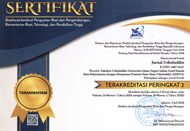Interpretation of Constellations in the Ilmi Interpretation of the Ministry of Religion and Its Implications for the Development of Astronomy and Astrology
Abstract
Keywords
Full Text:
PDFReferences
Afif, Wahid Nur. “Bintang Dalam Perspektif Al-Qur’an (Studi Tafsir Tematik).” IAIN Ponorogo, 2019.
Al-Azizi, Abdul Syukur. Untold Islamic History. Diedit oleh Yanuar Arifin. 1 ed. Yogyakarta: Laksana, 2018.
Al-Baqi, Muhammad Fu’ad Abd. Al-Mu’jam Al-Mufahras Li Alfazh Al-Qur’an Al-Karim. 1 ed. Kairo: Dar Al-Kutub Al-Mishriyah, n.d.
Al-Fattah, Muhammad Hatta. 40 Sumpah Terdahsyat Dalam Al-Quran: Mengungkap Rahasia Ayat-Ayat Sumpah Terdahsyat Dalam Al-Quran. Diedit oleh Jasam Nasrullah. 1 ed. Jakarta: Mirqat, 2012.
Bentara Budaya. Seri Lawasan: Pranata Manggsa. Jakarta: Kepustakaan Populer Gramedia, 2011.
Cahyowati, Lina, dan Estiarto Wahyu Sumirat. “Aplikasi Ramalan Bintang Berbasis Multimedia.” Journal Speed-Sentral Penelitian Engineering dan Edukasi 2, no. 1 (2010): 37–45.
Daldjoeni, N. Penanggalan Pertanian Jawa Pranatamangsa: Peranan Bioklimatologis dan Fungsi Sosiokulturalnya. Diedit oleh Badan Penelitian dan Pengembangan Pendidikan dan Kebudayaan Indonesia. 1 ed. Yogyakarta: Proyek Javanologi, 1983.
Ezokanzo, Tethy, dan Wahyu Annisha. Fenomena Alam Unik. Diedit oleh Dewi Hannie. 1 ed. Jakarta: Bhuana Ilmu Populer, 2019.
Fadhilah, Astrida Nurul. “Tafsir Ilmi tentang Bintang dalam Al-Quran: Studi Komparatif Tafsir Al-Jawahir karya Thanthawi Jauhari dan Tafsir Ilmi karya Tim Lajnah Pentashihan Mushaf Al-Quran.” UIN Sunan Gunung Djati, 2019. http://digilib.uinsgd.ac.id/29267/.
Faizin, Faizin. “Integrasi Agama dan Sains dalam Tafsir Ilmi Kementerian Agama RI.” Jurnal Ushuluddin 25, no. 1 (2017): 19. https://doi.org/10.24014/jush.v25i1.2560.
Fatimah. “Ayat-ayat Sains Dalam Al-Quran ( Tela’ah Balaghoh).” Al-Hikmah 5, no. 2 (2017): 1–9.
Ferza, Aditya Putra. “Simulasi Pengamatan Dan Pengenalan Rasi Bintang Dan Karakteristiknya Dengan Menggunakan Teknologi Google Cardboard.” Institut Teknologi Sepuluh Nopember, 2016.
Hartono. Geografi: Jelajah Bumi dan Alam Semesta. Diedit oleh Toni Kurniawan. 1 ed. Bandung: Citra Praya, 2007.
Izal M., Muhammad. “Bintang Syi’ra Dalam Perspektif Mufassir Dan Sains.” UIN Walisongo, 2019.
Jawhari, Tantawi. Al-Jawahir fi Tafsir Al-Qur’an Al-Karim Jilid 3. Mesir: Musthafa Al-Baby Al-Halaby, 1950.
Lajnah Pentashihan Al-Quran Kemenag RI, dan Lembaga Ilmu Pengetahuan Indonesia (LIPI). Manfaat Benda-Benda Langit dalam Perspektif Al-Quran dan Sains. Diedit oleh Lajnah Pentashihsan Mushaf Al-Quran. 1 ed. Jakart: Lajnah Pentashihsan Mushaf Al-Quran, 2012.
Lubis, Maisy Rezkiani. “Makna Al-Burûj Dalam Al-Quran Menurut Thanthawi Jawhari Dalam Tafsir Al-Jawahir.” UIN Sultan Syarif Kasim Riau, 2020. http://repository.uin-suska.ac.id/28433/.
Mardiah, Hidayatul. “Ayat-Ayat Alam Semesta dalam AL-Quraan (Penafsiran Tentang Langit dan Bumi) Prespektif Tafsir Ilmi Kemenag-LIPI.” UIN Raden Intang, 2018.
Marwab bin Musa, Abu Yahya. Hidayatul Insan bi Tafsir Al-Qur’an Al-Karim. Vol. 3, 2010. www.tafsir.web.id.
Mustaqim, Riza Afrian. Ilmu Falak. Diedit oleh Dedi Fazriansyah Putra. 1 ed. Aceh: Syiah Kuala University Press, 2021.
Nurfahizya, dan Alimuddin. “Metode Perbandingan Pengukuran Arah Kiblat Menggunakan Rasi Bintang dengan Azimuth Matahari.” Hisabuna: Ilmu Falak 2, no. 3 (2021): 148–62.
Pamungkas, Suroso Aji. Horoskop Jawa. Diedit oleh Tim Narasi. 1 ed. Yogyakarta: NARASI, 2009.
Prof. Achmad Baiquni M. Sc, Ph. D. Al-Qur’an Dan Ilmu Pengetahuan Kealaman. Diedit oleh Drs. Sonhadji, Ir. Abdul Jabar, dan Dra. Tri Saputrasari. 1 ed. Yogyakarta: PT. Dana Bhakti Prima Yasa, 1996.
Purwanti, Fitri. “Penafsiran Ayat-ayat Astronomi Agama (Studi Metode Tafsir Ilmi Kementerian Agama).” Al-Fath 12, no. 01 (2018): 2018.
Saputra, Sadri, dan Muammar Bakri. “Implementasi Rasi Bintang Navigasi Bugis Perspektif Ilmu Falak.” Hisabuna: Ilmu Falak 1, no. 1 (2020): 118–28.
Sayehu. “Urgensi Astrolabe Dalam Peradaban Astronomi Islam.” Al-Ahkam: Jurnal Hukum, Sosial dan Keagamaan 14, no. 1 (2018): 104–12. https://doi.org/10.37035/ajh.v14i1.1484.
Shihab, M. Quraish. Tafsir Al-Mishbah (Pesan, Kesan dan Keserasian Al-Qur’an) Jilid 5. IV. Jakarta: Lentera Hati, 2005.
Srimulyani, Elin. “Fenomena Bintang Al-Syi’ra Dalam Ilmu Astronomi (Implementasi Muatan Tafsir bil Ma’tsur Dalam Tafsir Jami’ Al-Bayan Fi Takwil Al-Qur’an Karya Imam Ath-Thabari).” UIN Syarif Kasim Riau, 2020. http://repository.uin-suska.ac.id/id/eprint/28424.
Thayyarah, Nadiah. Buku Pintar Sains Dalam Al-Qur’an. Diedit oleh Chairul Ahmad. 2 ed. Jakarta: Zaman, 2013.
Tim Tafsir Ilmiah Salman ITB. Tafsir Salman: Tafsir Ilmiah Juz ’Amma. Diedit oleh Ahmad Baiquni. 1 ed. Bandung: Mizan Pustaka, 2014.
Yanto, Muhammad Firli. “Studi Analisis Penentuan Waktu Rasdu Al-Qiblah Harian Bintang Menggunakan Astrolabe RHI.” UIN Walisongo Semarang, 2019.
DOI: http://dx.doi.org/10.24014/jush.v30i2.17031
Refbacks
- There are currently no refbacks.
 Jurnal Ushuluddin Indexed By:
Jurnal Ushuluddin Indexed By:
Alamat Redaksi:
 Fakultas Ushuluddin UIN SUSKA Riau Jl. H.R. Soebrantas KM. 15,5 Panam – Pekanbaru
Fakultas Ushuluddin UIN SUSKA Riau Jl. H.R. Soebrantas KM. 15,5 Panam – Pekanbaru
 E-mail: jurnal.ushuluddin@uin-suska.ac.id
E-mail: jurnal.ushuluddin@uin-suska.ac.id
ejournal: http://ejournal.uin-suska.ac.id/index.php/ushuludin

Jurnal Ushuluddin is licensed under a Lisensi Creative Commons Atribusi 4.0 Internasional.


















